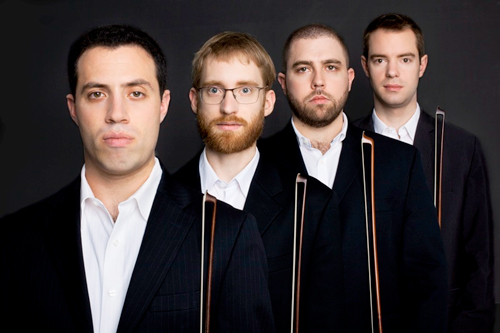by Mike Telin

On Tuesday, March 1 at 7:30 pm in Transformer Station the JACK will perform Georg Friedrich Haas’s pioneering String Quartet No. 3. Then on Wednesday, March 2 at 7:30 pm, the quartet will take the stage in the Museum’s Gartner Auditorium for a concert featuring works by Guillaume de Machaut, John Zorn, Claudio Monteverdi, and Caroline Shaw. The evening will also include two world premieres by Cenk Ergün. “We’re very excited about these concerts,” violinist Ari Streisfeld said during a telephone interview. “We hope everyone will come with open ears and open minds.”
Austrian composer Georg Friedrich Haas’s String Quartet No. 3 is a groundbreaking work for many reasons, not the least of which is that the composer asks for it to be performed in complete darkness. “It’s a phenomenal piece, and we like it a lot, but I don’t think the piece would work in the same way if the lights were on,” Streisfeld said. “Haas told us that when he conceived of the idea for the piece, he could have written a quartet that needed to be memorized note for note. But he decided that this was an opportunity for him to do something a little different and give the performers the possibility to develop the material that he would give them. It’s smartly written, because expecting a string quartet to memorize a difficult, complex score and play it in complete darkness is kind of ridiculous, if you will. But we’ve played the piece for many years, and it’s not as difficult to memorize as you would think.”
Streisfeld explained that the piece is organized into eighteen sections, each of which contains a specific “invitation” or gesture of some kind as well as a specific “acceptance” to that invitation. “One of us will send out an invitation to a certain section, and someone else then plays the acceptance, and we all have to jump in and realize that section based on its various parameters and rules. Haas says that you’re supposed to accept every three to eight invitations, so a good portion of the piece is just us sending out invitations to each other, and then waiting for an acceptance. It’s a highly controlled improvisation but it has structure and elements that reoccur.”
The work does have sections with written scores, one of which quotes music of Gesualdo from the 16th century. “Haas is very specific that this section has to happen about 75% of the way through the piece,” Streisfeld said. “During performances that delineates how much further we need to go before we reach the conclusion. We never really know how long a performance is going to be. We’ve had some that have gone up to 80 minutes, and others that have been 50 minutes. Haas says it has to be at least 35, which we’ve never had any problem reaching because the piece has a funny way of getting you to lose track of time as you’re performing it or listening to it. The first time I heard it was when I was a student at the Lucerne Academy, and I had no idea that 40 minutes had passed. It felt like 10 to me.”
Streisfeld noted that after getting many performances of the work under their belts, the group’s interpretation of the piece has evolved. “Over time we’ve looked beyond Haas’s rules and have found new things within them, and I have a feeling this is what he intended.”
Performing a work in complete darkness has been a cause for concern for some presenters, and a few have asked audiences to sign a waiver. “One of the first performances of the piece we gave was for the Monday Evening Concert Series in Los Angeles. The presenter called me and asked how dark the room really had to be, and I told him that Haas would like it to be pitch black,” Streisfeld recalled. “The presenter called back in a couple of weeks and told me that he was speaking to a guy in L.A. who specializes in dark events, and they had found a space and blacked it out.
“Although we have done it in spaces that have been very dark, to this day that has been the only space we’ve performed in where I could not see an inch in front of my face for the entire performance. The ushers had night goggles, but he wanted to make sure everything was done correctly so he created these waivers. I think if people have to sign a waiver to go to a classical music concert, it gives the event a little more of an edge.”
In addition to the world premieres of Cenk Ergün’s Sonare and Celare, the JACK’s Gartner Auditorium program will also include Guillaume de Machaut’s Three Pieces (arr. Ari Streisfeld), John Zorn’s The Remedy of Fortune, Claudio Monteverdi’s Selections from L’Orfeo (arr. Kevin McFarland), and Caroline Shaw’s Ritornello.
“We like to do ‘Modern-Medieval’ programs where we pair our own arrangements of works from the Medieval and Renaissance periods with modern pieces. Zorn’s piece is inspired by Machaut’s great poem The Remedy of Fortune — it was written for us and we premiered it last year. The opening sonorities of Caroline Shaw’s quartet, which she also wrote for us, are the same as the Monteverdi. And I’m sure there will be connections that can be made with Cenk’s music. We find it interesting to go back and look at the experimental music of earlier days with new ears so audiences can hear how radical that music was during its time.”
Published on ClevelandClassical.com February 23, 2016.
Click here for a printable copy of this article



